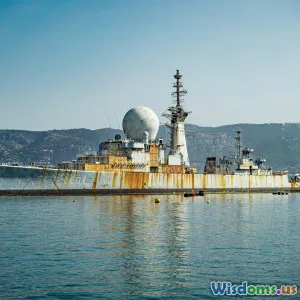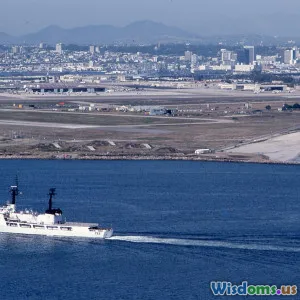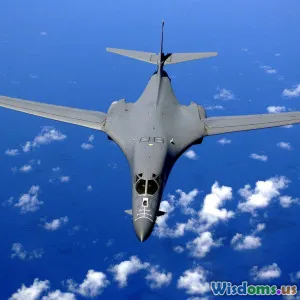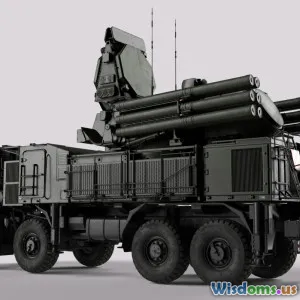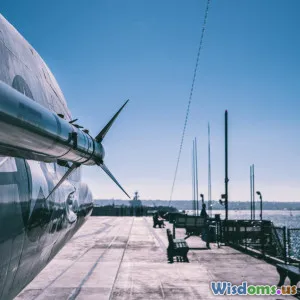
How Stealth Technology Changed Cruise Missile Effectiveness Forever
10 min read Explore how stealth technology revolutionized cruise missile effectiveness, enhancing military precision and altering global defense dynamics. (0 Reviews)
How Stealth Technology Changed Cruise Missile Effectiveness Forever
Stealth technology's rise represents a cornerstone in modern military innovation. Among weapon systems, cruise missiles stand notably transformed by these technological advances, profoundly amplifying their lethality and survivability. This article takes a deep dive into how stealth design elements have forever altered cruise missile warfare, transforming strategic doctrines and global defense postures.
Introduction: A Game-Changer in Modern Warfare
Stealth technology, broadly characterized by design and material innovations that minimize radar and infrared signature, has reshaped numerous combat domains. While stealth applications originated prominently with aircraft such as the B-2 Spirit bomber, their influence expanded onto missile technologies, particularly cruise missiles.
Cruise missiles are typically low-flying guided weapons designed to deliver precise payloads over long distances. Their inherent vulnerability to radar detection posed significant operational risks during Cold War and post-Cold War era engagements. The development and integration of stealth principles into these missiles have not only enhanced survivability but also dramatically increased strike effectiveness.
Understanding this transformation requires analyzing both the evolution of stealth technology and its concrete impact on missile design, mission execution, and strategic implications.
The Evolution of Cruise Missiles Before Stealth
The Cold War Context
Early cruise missiles, such as the American Tomahawk and Soviet Kh-55, reached operational status during the latter half of the 20th century. Their success owed to extended ranges and accurate guidance systems. Yet, their detectable radar cross-sections (RCS) and relatively slow speeds left them vulnerable to increasingly sophisticated air defense networks.
Radar systems during this period achieved higher resolution and tracking capabilities. Surface-to-air missile (SAM) sites and interceptor aircraft posed consistent threats, compelling missile developers to innovate ways to avoid detection.
Key Limitations
- Radar Visibility: Early cruise missiles had characteristic shapes and metal surfaces reflecting radar waves strongly.
- Predictable Flight Paths: Launch vectors and flight patterns were often detectable.
- Limited Low-Altitude Capability: Terrain following was primitive, making radar detection easier.
These vulnerabilities resulted in missile losses or mission failure during many conflicts or tests, highlighting the need for improved survivability measures.
Stealth Technology: Core Principles and Application to Missiles
What is Stealth Technology?
Stealth technology primarily focuses on reducing detectability by enemy sensors—particularly radar, infrared, acoustic, and visual. Reducing radar cross-section involves:
- Shaping: Employing angular surfaces and curves that reflect radar waves away from their origin rather than straight back.
- Radar-Absorbent Materials (RAM): Specialized coatings that absorb rather than reflect radar.
- Infrared Suppression: Managing heat emissions to evade IR sensors.
Integrating Into Cruise Missile Design
The challenge was applying these principles while maintaining aerodynamic efficiency and payload capacity. Designers began rethinking:
- Airframe Shapes: Incorporation of smooth, blended surfaces and edge alignment to dissipate radar signals.
- Surface Treatments: Use of absorbent coatings that withstand high-speed airflow and temperatures.
- Engine Exhaust Modifications: Designing plume suppression to limit IR signature.
Example: The AGM-129 Advanced Cruise Missile
One of the earliest widely recognized stealthy cruise missiles, the AGM-129 entered U.S. service in the early 1990s. It featured:
- Low observable design with curved surfaces minimizing RCS
- RAM coating
- Infrared signature management
The AGM-129 illustrated how stealth could enable cruise missiles to penetrate sophisticated air defenses effectively.
How Stealth Technology Enhanced Cruise Missile Effectiveness
1. Dramatically Increased Survivability
Stealth features make cruise missiles substantially harder to detect and track, increasing the likelihood of reaching their targets:
- By reducing radar signature up to 90% compared to non-stealth models, adversary radar operators have less warning time.
- Enhanced low-altitude terrain-following flight combined with stealth allows missiles to fly under radar coverage “shadows.”
For instance, during NATO's 1999 Kosovo campaign, stealthy missile variants demonstrated notable success in evading Yugoslav air defenses.
2. Improved Penetration of Integrated Air Defense Systems (IADS)
Modern air defenses integrate multiple detection and interception technologies. Stealthy cruise missiles challenge these by:
- Minimizing multispectral detection, forcing adversaries to increase sensor density and complexity.
- Creating confusion and requiring extensive resource allocation for radar cross-verification.
A report by RAND Corporation highlighted that stealth reduces the need for large missile salvos, enabling precision saturation strikes with fewer resources.
3. Expanded Tactical and Strategic Options
Reduced detection risk encourages:
- Preemptive and Surprise Strikes: Planning operations that rely on achieving surprise becomes more feasible.
- Smaller Launch Platforms: Stealth enables launch platforms (e.g., submarines, aircraft) to fire missiles while remaining concealed.
- Flexible Targeting: Surge capability against heavily defended high-value targets.
The U.S. Navy’s development of the Long-Range Anti-Ship Missile (LRASM), inheriting stealth principles, exemplifies this: its ability to evade extensive defense networks improves maritime strike capabilities substantially.
4. Cost-Benefit Advantages
Although stealth coatings and shaping add design complexity and expense, the increase in missile effectiveness translates to:
- Reduced unit losses
- Lower chance of mission failure
- Less need for expensive support missions (e.g., electronic warfare escorts)
Operational cost savings and enhanced mission success rates have been confirmed in multiple defense analyses.
Real-World Examples and Operational Impact
Operation Allied Force, 1999
This NATO campaign was a revealing case where stealth-enhanced Tomahawks played a critical role.
- Tomahawks with improved radar signature reductions penetrated dense Yugoslav air defenses.
- Successes led to high-value targets being neutralized early, swinging operational momentum.
The AGM-158 JASSM
This is a modern, stealthy cruise missile capable of avoiding detection through its low RCS and engine IR suppression.
- It’s been used extensively by the USAF, reshaping strike doctrines.
- Its collaboration with stealth platforms like the B-2 bomber synergizes low observability.
Advancements in Hypersonic and Next-Gen Missiles
Stealth techniques even influence development of hypersonic cruise missiles – though achieving stealth at extreme speeds poses new engineering challenges, lessons from traditional cruise missile stealth remain foundational.
Challenges and Future Outlook
Counter-Stealth Technologies
As stealth missile use proliferates, radar and sensor technologies evolve:
- Low-frequency radars can detect stealth shapes but lack precision
- Multistatic radar networks and space-based sensors aspire to track low-RCS targets persistently
Thus, stealth is a continual arms race, pushing further innovations in materials, active countermeasures, and electronic warfare.
Integration with AI and Autonomous Systems
Future cruise missiles may include AI-driven navigation and adaptive flight patterns combined with stealth for unpredictable, difficult-to-intercept trajectories.
Environmental and Ethical Considerations
Stealth-enhanced missiles increase the precision of strikes, potentially minimizing collateral damage but raising ethical debates over targeted warfare and strategic escalation.
Conclusion: Stealth Technology as a Strategic Force Multiplier
Stealth technology has irrevocably transformed cruise missile effectiveness, turning these weapons from detectable threats into near-invisible precision tools. Through innovative shaping, materials, and engineering, missile survivability and lethality have skyrocketed, enabling unparalleled operational agility and strategic options.
From the Cold War’s challenges to today’s complex battlefields, stealth-enabled cruise missiles have become indispensable in modern military arsenals globally. The continuous evolution in stealth and detection technologies promises an ongoing cycle of innovation, redefining warfare and geopolitical power balances for decades.
Understanding and leveraging these advancements is crucial for nations aiming to maintain military relevancy and protect strategic interests in an increasingly contested world.
References:
- RAND Corporation, "Stealth and Air Defence Systems: Effects on Cruise Missile Confrontations," 2001
- Federation of American Scientists (FAS), ‘‘AGM-129 Advanced Cruise Missile Fact Sheet’’
- Jane's Defence Weekly, Multiple articles on stealth missile development
- Office of Naval Research, ‘‘Next Generation Cruise Missile Development’’
Rate the Post
User Reviews
Other posts in stealth technology
Popular Posts










